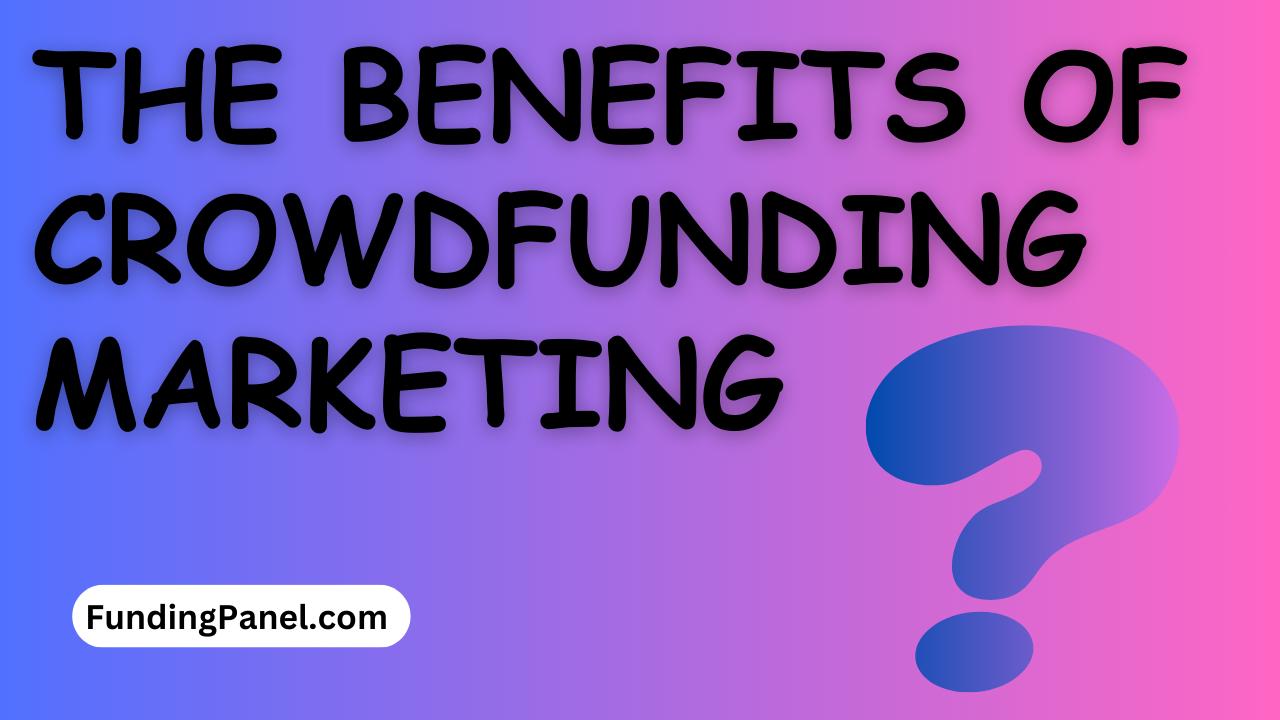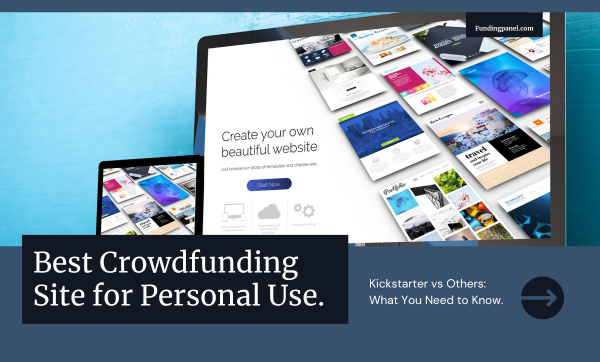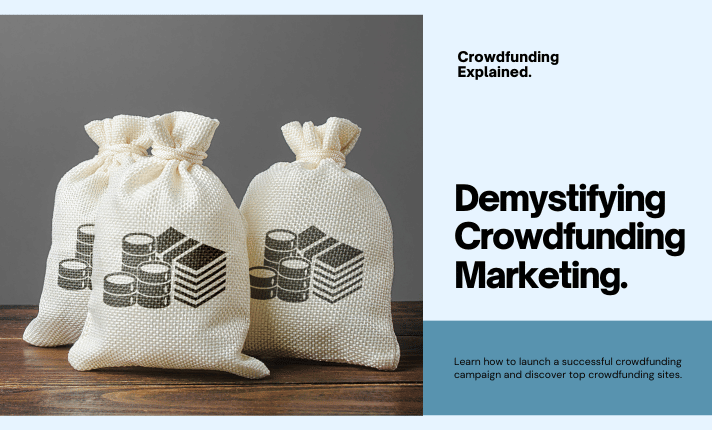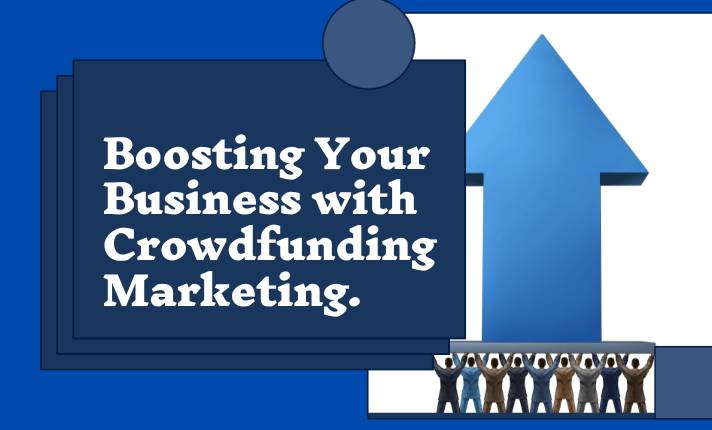What is Crowdfunding Marketing?
Crowdfunding marketing refers to the strategies and activities employed to promote a crowdfunding campaign. Crowdfunding is a method of raising funds for a project or venture by collecting small contributions from a large number of people, typically through online platforms.
These campaigns can be for various purposes, such as launching a new product, funding a creative project, supporting a cause, or financing a startup.
Crowdfunding marketing involves creating awareness, generating interest, and encouraging people to contribute to the campaign. Here are some key components of crowdfunding marketing:
Online Presence: Establishing a strong online presence is crucial. This includes creating a dedicated website or landing page for the campaign, as well as leveraging social media platforms to reach a broader audience.
Compelling Storytelling: Crafting a compelling and relatable story about the project or cause helps connect with potential backers emotionally. A good story can make the campaign more memorable and shareable.
Engaging Content: Utilizing various types of content, such as videos, images, and infographics, can help convey the project’s message effectively. High-quality visuals and well-crafted content can capture the attention of potential backers.
Social Media Marketing: Leveraging social media platforms is essential for crowdfunding success. Regular updates, engaging posts, and interactions with the audience help maintain momentum and build a community around the campaign.
Email Marketing: Building and maintaining an email list allows campaigners to communicate directly with potential backers. Email updates, newsletters, and targeted messages can keep supporters informed and engaged.
Influencer Outreach: Collaborating with influencers or individuals with a significant following in the campaign’s niche can help extend its reach. Influencers can introduce the project to a larger audience and provide credibility.
Public Relations: Generating media coverage through press releases, interviews, and articles can increase the campaign’s visibility. Positive media attention can attract more backers and build trust in the project.
Crowdfunding Platforms: Optimizing the campaign page on the chosen crowdfunding platform is crucial. This includes a clear and concise project description, appealing visuals, and transparent information about how the funds will be used.
Backer Engagement: Actively engaging with backers by responding to comments, addressing concerns, and showing appreciation helps build a supportive community. Happy backers are more likely to share the campaign with their networks.
Launch and Mid-Campaign Push: A strong launch is essential to create initial momentum. Mid-campaign efforts, such as special promotions, updates, and stretch goals, can re-energize the campaign and attract new backers.
Successful crowdfunding marketing requires a combination of these elements, adapted to the specific goals and nature of the campaign. It’s about creating a compelling narrative, building a community of supporters, and strategically utilizing various online channels to reach and inspire potential backers.
The Benefits of Crowdfunding Marketing .

Crowdfunding offers several benefits, both for project creators and backers. Here are some key advantages:
Crowdfunding Marketing Access to Funding: One of the primary benefits of crowdfunding is that it provides a means for individuals and businesses to access funding that might be challenging to obtain through traditional avenues like banks or investors. It allows for a diverse range of projects, from creative endeavors to social causes and entrepreneurial ventures, to receive financial support.
Crowdfunding Marketing Validation of Ideas: Crowdfunding serves as a validation tool for ideas and projects. If a campaign successfully attracts backers and meets its funding goals, it indicates a level of market demand and support. This validation can be valuable for entrepreneurs seeking to bring new products or services to the market.
Crowdfunding Marketing Market Testing: Campaigners can use crowdfunding to test the market before fully launching a product or project. By gauging interest and collecting feedback during the crowdfunding campaign, creators can make adjustments and improvements based on real-time input from potential customers.
Crowdfunding Marketing Community Building: Crowdfunding enables the creation of a community around a project or cause. Backers become more than just funders; they become advocates and supporters who are emotionally invested in the success of the campaign. This sense of community can extend beyond the campaign, fostering long-term relationships between creators and backers.
Crowdfunding Marketing Reduced Financial Risk: For backers, crowdfunding offers a way to support projects they believe in without committing large sums of money. The contribution amounts can vary, and backers often receive rewards or early access to the project in return for their support. This reduced financial risk encourages more people to participate.
Crowdfunding Marketing Innovation: Crowdfunding supports innovation by providing a platform for unconventional and niche projects. Inventors, artists, and entrepreneurs with unique ideas can find a supportive audience willing to fund projects that may not align with mainstream investment criteria.
Crowdfunding Marketing Global Reach: Online crowdfunding platforms have a global reach, allowing creators to access a diverse and widespread audience. This global exposure can attract backers from different countries and cultures, contributing to a more diverse and inclusive funding base.
Crowdfunding Marketing Flexible Funding Models: Crowdfunding platforms often offer different funding models, including all-or-nothing and flexible funding. All-or-nothing models require the project to reach its full funding goal for any money to be collected, ensuring that the creator has the necessary resources to fulfill their plans. Flexible funding allows creators to access funds even if the goal is not fully met, providing more flexibility in certain situations.
Marketing and Publicity: Running a crowdfunding campaign can serve as a marketing and publicity opportunity. The campaign itself generates attention, and successful projects may attract media coverage. This exposure can be beneficial for the long-term success of the project and can even lead to additional opportunities.
Crowdfunding Marketing Empowerment: Crowdfunding empowers both creators and backers. Creators have the autonomy to bring their ideas to life with the support of a community, while backers have the power to contribute directly to projects and causes they believe in, influencing the direction of innovation and creativity.
While crowdfunding offers numerous benefits, it’s important to note that success is not guaranteed, and effective planning, marketing, and execution are crucial for a campaign to reach its funding goals.
Here are seven effective marketing strategies for Crowdfunding Marketing campaigns.
Implementing effective marketing strategies is essential for the success of a crowdfunding campaign. Here are seven great crowdfunding marketing strategies to maximize your chances of reaching and surpassing your funding goals:
Crowdfunding Marketing Compelling Storytelling:
- Craft a compelling and relatable story about your project. Communicate the purpose, inspiration, and impact of your campaign. Use emotionally engaging language to connect with potential backers on a personal level.
Crowdfunding Marketing Engaging Visuals:
- Utilize high-quality visuals, including images and videos, to showcase your project. Visual content is more likely to capture attention and convey your message effectively. Create a visually appealing campaign page that clearly illustrates the product, prototype, or essence of your project.
Crowdfunding Marketing Social Media Campaigns:
- Leverage the power of social media platforms to create awareness and drive traffic to your crowdfunding campaign. Develop a strategic social media plan that includes regular updates, engaging content, and interactions with your audience. Consider using targeted ads to reach specific demographics.
Crowdfunding Marketing Email Marketing:
- Build and utilize an email list to keep potential backers informed and engaged. Send regular updates, newsletters, and personalized messages to your email subscribers. Use email marketing to share important milestones, behind-the-scenes insights, and exclusive content.
Influencer Collaborations:
- Identify and collaborate with influencers in your niche or industry. Influencers can help expand your reach by promoting your campaign to their followers. Choose influencers whose audience aligns with your target demographic to ensure the most effective impact.
Early Bird Specials and Limited Offers:
- Create a sense of urgency and exclusivity by offering early bird specials or limited-time discounts for the first backers. Limited offers can incentivize people to contribute early and create a sense of excitement around your campaign launch.
Interactive and Engaging Updates:
- Keep your backers engaged throughout the campaign by providing regular and interactive updates. Share progress, and milestones, and respond to comments and messages promptly. Consider incorporating live Q&A sessions, polls, or contests to make the campaign more interactive and dynamic.
Partnerships and Collaborations:
- Seek partnerships with complementary businesses or organizations that can help promote your campaign. Collaborate with entities that share an interest in your project or target the same audience. Joint ventures can significantly expand your campaign’s visibility.
Remember that a successful crowdfunding campaign requires a comprehensive and well-executed marketing plan. Tailor these strategies to fit your project and audience, and be adaptable to changes and feedback as your campaign progresses. Additionally, maintain transparency, build a sense of community, and express gratitude to your backers for their support throughout the entire crowdfunding process.
5 crowdfunding marketing ideas that bring lift-off
Launching a successful crowdfunding campaign requires innovative and impactful marketing ideas to capture the attention of potential backers. Here are five crowdfunding marketing ideas to give your campaign a strong lift-off:
Interactive Launch Event:
- Host an interactive and engaging launch event to kick off your crowdfunding campaign. This could be a live stream on social media platforms where you introduce your project, showcase prototypes, and interact with your audience in real time. Consider incorporating Q&A sessions, giveaways, or exclusive behind-the-scenes content to make the launch event memorable.
Viral Social Media Challenges:
- Create a buzz around your campaign by launching viral challenges on social media platforms. Encourage backers to share creative content related to your project, using a specific hashtag. This not only increases visibility but also leverages user-generated content to promote your campaign organically. Offer rewards or shout-outs to participants to incentivize engagement.
Innovative Teasers and Trailers:
- Build anticipation for your crowdfunding campaign by releasing innovative teasers and trailers. Create visually striking videos that highlight the uniqueness and benefits of your project. Use storytelling techniques to evoke emotions and make potential backers eager to learn more. Share these teasers across social media, email newsletters, and your campaign page.
Limited-Edition Merchandise or Rewards:
- Introduce limited-edition merchandise or exclusive rewards that are only available to backers during the crowdfunding campaign. This creates a sense of exclusivity and urgency, encouraging people to support your project to gain access to these special items. Make sure the rewards are aligned with the theme of your project and offer genuine value to backers.
Crowdfunding Marketing Challenges and Milestones:
- Set specific challenges or milestones for your crowdfunding campaign and engage your audience in achieving them. For example, you could introduce stretch goals that unlock additional features or rewards when funding reaches a certain level. Communicate these challenges to your backers through updates, social media, and email, turning the campaign into an exciting journey with tangible progress.
Remember to maintain a consistent and active online presence throughout your campaign. Respond promptly to comments, questions, and feedback. Additionally, consider incorporating elements of gamification, such as leaderboards or badges, to keep backers motivated and engaged. These creative marketing ideas not only attract attention at the launch but also contribute to the sustained momentum of your crowdfunding campaign.
Crowdfunding Marketing Frequently Asked Questions.
Certainly! Here are some frequently asked questions (FAQs) related to crowdfunding campaigns:
What is Crowdfunding Marketing ?
- Crowdfunding is a fundraising method where individuals or businesses raise small amounts of money from a large number of people, typically through online platforms, to support a specific project or venture.
How does Crowdfunding Marketing work?
- Creators create a campaign on a crowdfunding platform, set a funding goal, and offer various rewards or incentives for backers. Interested individuals contribute money to the campaign, and the project receives the funds if the goal is met within a specified timeframe.
What types of projects can be crowdfunded?
- Crowdfunding is versatile and can be used for various projects, including product launches, creative endeavors (such as films or music albums), charitable causes, medical expenses, and business startups.
What are the different crowdfunding models?
- There are two main crowdfunding models: reward-based and equity-based. Reward-based crowdfunding involves backers receiving non-financial rewards, such as the product being funded. Equity-based crowdfunding allows backers to become shareholders in the venture.
How do I choose the right crowdfunding platform?
- Consider the nature of your project, the platform’s fees, its user base, and the type of crowdfunding it supports. Popular platforms include Kickstarter, Indiegogo, GoFundMe, and SeedInvest.
What should be included in a crowdfunding campaign?
- A compelling story, clear project description, funding goal, timeline, and attractive rewards for backers are crucial elements. Including visuals like images and videos can enhance your campaign’s appeal.
What happens if the funding goal is not reached?
- It depends on the crowdfunding model. In an “all-or-nothing” model, the project receives no funds if the goal isn’t met. In a “flexible funding” model, the project receives the funds raised, even if the goal is not reached.
How can I promote my crowdfunding campaign?
- Utilize social media, email marketing, influencer partnerships, and other digital marketing strategies. Engage your network, share updates regularly, and consider hosting events or promotions to boost visibility.
What is a stretch goal?
- A stretch goal is an additional funding target set beyond the initial goal. Achieving stretch goals often unlocks new features, improvements, or additional rewards for backers.
How do I keep backers engaged during and after the campaign?
- Regularly update backers on the project’s progress, share behind-the-scenes content, and fulfill rewards promptly. Building a sense of community and expressing gratitude helps maintain positive relationships with backers.
These FAQs provide a general overview of crowdfunding. Specific details may vary based on the chosen platform and the nature of the campaign.
Final Thoughts on Crowdfunding Marketing.
In conclusion, crowdfunding marketing is a dynamic and powerful tool that empowers individuals and businesses to bring their ideas to life, garnering support from a widespread community. As you embark on a crowdfunding campaign, here are some final thoughts to keep in mind:
Strategic Planning is Key:
- Successful crowdfunding campaigns don’t happen by chance. A well-thought-out and strategic marketing plan is crucial. Define your goals, identify your target audience, and plan your marketing strategies accordingly.
Compelling Storytelling Sells:
- Craft a compelling and authentic story around your project. Connect with your audience on an emotional level, and communicate the purpose and impact of your campaign. A strong narrative is often the driving force behind successful crowdfunding efforts.
Engagement Builds Community:
- Actively engage with your backers and potential supporters. Respond to comments, messages, and feedback promptly. Building a sense of community around your project can lead to long-term support and advocacy.
Transparency Builds Trust:
- Be transparent about your project, the use of funds, and any challenges you may face. Transparency builds trust with backers, and a trustworthy campaign is more likely to attract support.
Utilize a Multichannel Approach:
- Diversify your marketing efforts across various channels. Leverage social media, email marketing, influencer partnerships, and any other relevant platforms to maximize your reach. A multichannel approach increases the chances of reaching a diverse audience.
Pre-launch Efforts Matter:
- Don’t underestimate the importance of pre-launch marketing. Build anticipation, create a buzz, and gather a community of supporters before your campaign officially begins. A strong start can set the tone for the entire campaign.
Adaptability is Crucial:
- Be prepared to adapt your marketing strategies based on the feedback and performance of your campaign. Monitor analytics, listen to your backers, and adjust your approach as needed to keep the momentum going.
Follow Through on Promises:
- Fulfill your promises and deliver rewards or products on time. This not only ensures the satisfaction of your backers but also contributes to your credibility for future projects or endeavors.
Learn from the Experience:
- Regardless of the outcome, view your crowdfunding campaign as a learning experience. Analyze what worked well and what could be improved. This knowledge can be invaluable for future projects and entrepreneurial endeavors.
Express Gratitude:
- Show appreciation to your backers and supporters. Whether your campaign succeeds or faces challenges, expressing gratitude fosters a positive relationship with your community.
In the ever-evolving landscape of crowdfunding, a combination of creativity, authenticity, and strategic thinking can significantly impact the success of your campaign. By embracing these principles and staying dedicated to your vision, you enhance your chances of not only reaching your funding goals but also building a community that believes in and supports your endeavors.











